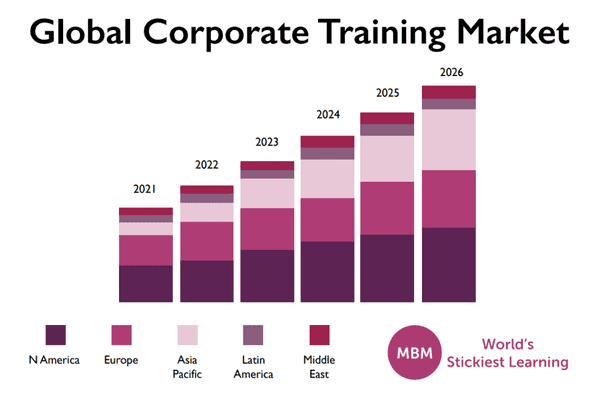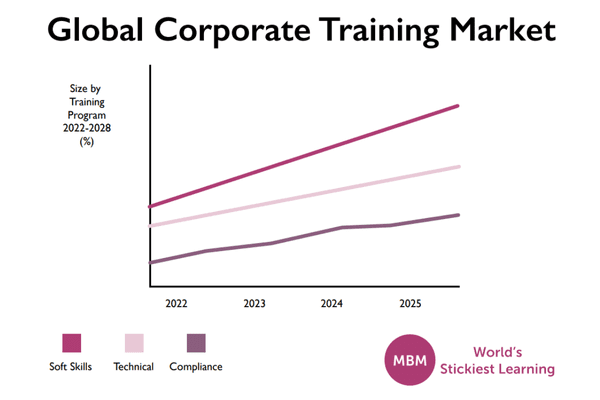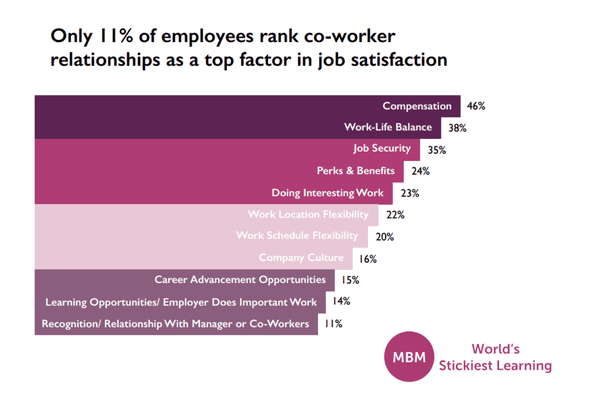Your Comprehensive Guide to the Training Industry
Learn everything you need about the Training Industry from the latest trends, news, and statistics in this complete 2024 report for HR managers with the help of two top experts in HR, Training, and Leadership & Teambuilding.
Introduction
The Training Industry exploded in 2020, with Covid and remote working. Spending inevitably slowed in the ensuing economic crisis, but it’s picked up since. Global Industry Research’s 2024 Global Corporate Training Market Report values the global training industry at $133.13 bn and forecasts it hitting $229.12 bn by 2031.
But guess who’s back? Virtual Reality!
With VR, the Training Industry is taking the learning experience to another level. First, the internet has made omnichannel learning on different platforms accessible to anyone, anytime, anywhere. Now, the widespread adoption of VR offers the Training Industry new realms of possibility.
Yet for HR managers trying to do their job and get people trained in the real world, the burning question remains – is VR the magic glue that will make training stick? Virtual reality offers a convenient, low-risk way to learn high-risk procedures, like flying planes, or medical surgery. But what about in other fields, like training bus drivers? Hopefully, VR’s ‘game-like’ connotations won’t detract people from the serious business of absorbing their training.
In this complete guide, you’re going to discover all about the Training Industry as it is today. You’ll learn about the importance of the training industry for HR managers, have a refresher on the principles of training with our FAQs, find out about the 6 types of training, how big the training industry market size is, what the likely ROI for training is, and what’s a good ROI for a training program. You’ll also be intrigued by our interviews with our prominently featured experts, energised by the quotes in our training industry inspiration section, and brought into focus on all this by our conclusion.
Calling out all: HR managers & L&D managers
📥 DOWNLOAD NOW ⇓
>> FREE GUIDES FOR HR MANAGERS AND TRAINING OFFICERS <<
Now the question is: how can you make the most of the Training Industry, achieve a higher ROI for your training, and witness employee transformation in the workplace? Well, that’s where this complete guide comes into play.
Jump to Section:
- I – What is the importance of the training industry for HR managers?
- II – Frequently Asked Questions About Training
- III – What are the 6 types of training?
- IV – How big is the training industry market size?
- V – What is the ROI for training?
- VI – What is a good ROI for a training program?
- VII – Interviews with the Experts
- VIII – Training Industry Inspiration
- Conclusion
Part I: What is the Importance of the Training Industry for HR Managers?

The Tech world has caught up with its ‘fluff’ management.
These companies were the ‘El Dorado’ for job seekers in recent years. But the recent layoffs have massively blown their covers. Now, for all their fancy offices and perks, we’re starting to see their true colours.
And the saying that big gains in a short time lead to big losses in a short time has never rung more true. As Berkshire Hathaway chairman and CEO Warren Buffet famously declared, “The stock market is a device for transferring money from the impatient to the patient.”
Ah, Mr Buffet, we need your wisdom! How have you been able to be so “patient”? Times change, but successful systems remain for a reason – because they work.
Interestingly enough, the Tech companies didn’t leverage the power and wealth of the training industry.
What a shame. What a crime. And what a (bleep.)
There, dear HR manager, I did your rant for you. You’re welcome.
There are only two ways a manager can impact an employee’s output: motivation and training. If you are not training, then you are neglecting half the job.” – Andy Grove.
Intel co-founder and CEO Andy Grove died in 2016. He wasn’t here to see the tech companies get it wrong about training, but he nailed it about the two things that matter most for managers wanting to get results.
The training industry plays a vital role in organisations’ development and success. With AI currently creating havoc, this applies now more than ever. As an HR manager, you know that for sure, what is sometimes challenging is getting it across to your CFO and colleagues.
So, let’s explore why the training industry is essential for HR managers and the benefits it brings to companies:
1.1 Enhancing Employee Skills and Knowledge
This is the big fear gripping workers in many industries: Will AI replace me? Will AI take away my job?
The ‘Rise of the Machines,’ the nightmare scenario we’re all familiar with from the ‘Terminator’ movies, isn’t a new anxiety in the world of work. Ask anyone who worked in offices in the 1970s, people feared mainframe computers replacing their roles. For sure, IT advances affect jobs, but it isn’t that clear-cut.
While Tech companies are not making it easy to counter these fears with their layoffs, training is a big part of the solution.
AI is here to stay, for everything from insurance policies to warehouse automation. ‘The computer says no.” But the reality is, that the future is not humans vs AI.
The future is humans + AI.
HR managers who are proactive in integrating AI within their companies will help enhance their employees’ skills and knowledge and better prepare them for the future.
But training does not stop at AI, the new tech is just one area of learning that training can address.
Training programs provide employees with the necessary skills and knowledge to perform their roles effectively. HR managers can identify skill gaps within their company, and design targeted training initiatives to address them.
By investing in your employees’ development, you can empower them to meet the demands of a rapidly changing business landscape. Above all, keep training real, and keep it human!
Sticky Learning ® is 7 times more effective than 1-day training courses. Plus, you will get a Chain of Evidence proving your Return on Investment. Discover soft skills training that changes behaviours long term.

1.2 Increasing Employee Productivity and Engagement
When you lead with effective training programs, this will have a direct impact on employee productivity and engagement.
Everyone feels empowered when they master a new skill. And when you encourage colleagues to participate in training opportunities, they feel valued and supported. Consequently, this will boost their engagement and productivity levels.
Employees want to help. They feel important when they are part of the solution. They will always do their best when rightly motivated.
Training can help you foster a positive work environment and drive higher employee satisfaction, leading to higher productivity and retention rates.
1.3 Supporting Organisational Growth and Adaptability
From the Tech companies’ recent behaviour, they have a clear deficiency in the training department. Specifically, they haven’t been able to adapt to the market changes and technological advancements. ChatGPT disrupted their plans, and there was no Plan B.
So, what’s that saying again?
It’s when the market is at its worst that is the best time to invest.
Because when the market goes back up again, people will remember you, but for the right reasons.
HR managers are crucial in aligning training initiatives with strategic business goals. By nurturing a culture of continuous learning, you ensure that employees are equipped with the skills they need to drive innovation and contribute to organisational growth. But remember to make learning fun, not something people resent.
And finally, and this is a big one: the type of training that is most appropriate for an employee will depend on both the individual’s needs and the needs of the company. You can work with employees to identify their training needs and develop a training plan that meets those needs.
To help get your training plans in perspective, take time out for a refresher on what training means to you as an HR professional, in our next section.
PART II: Frequently Asked Questions About Training
Some people are sceptical about what HR is there for! Let’s clear that up. First, HR’s mission is to service the business, by ensuring the right ‘human resources’ are there to do the work. That’s a given. So where does training come in? Well, HR’s equally important role is to develop the employees, by making sure they have the right kind of training to bring out their potential. And the bottom line is, training costs time and money. So it’s important for training programs to achieve at least a satisfactory ROI. Here are some issues around training, for you to think about.
2.1 The Right Training Could Change Someone’s Life
To be fair, the British education system doesn’t help with people’s attitudes to work and workplace training! First, it divides children at an early age into ‘academic’ and ‘non-academic.’ Then, at age 11, only giving relatively few children access to selective secondary schools causes social division, impacts the life chances of those denied such opportunities, and affects their attitudes to work. Even so, employers can do much to improve their people’s prospects, by making the selection and recruitment process welcoming and sympathetic for everyone, and investing in appropriate training for successful applicants.
2.2 What are the 4 Types of Training and Development?
The Human Capital hub talks about these:
- Induction/orientation: Orienting new employees to the business
- Profession/job
- Training for profession
- Refresher training
Induction or orientation is crucial for successfully onboarding new employees. People have different expectations about different kinds of jobs, and onboarding people on zero-hours contracts is very different to onboarding a new manager or technical staff. However, it’s safe to generalise that you need to introduce all recruits to the business, show them how things work, and make them feel welcome from day 1. If you don’t do the onboarding properly, they may not stick around.
Profession/job training gives people the knowledge, skills and attitude they need for a job. See 2.4 below, ‘What Does Training Teach?’
Training for professions ensures these employees have a body of knowledge associated with that industry. Completing this training is often dignified by giving the qualifications the word ‘chartered’ in the title, as with accountancy and surveying. The idea of chartered status goes back to mediaeval Britain when the king granted rights and privileges to people in particular occupations. Other industries like insurance and communications also have recognised qualifications, but don’t elevate their status in the same way. We’ll hear about them in a moment.
Refresher training can go hand in hand with job rotation when you need people to change jobs to fit work schedules. This kind of training can also help reduce the impact of labour shortages, for example in warehouses, by keeping people motivated. Which brings us to,
2.3: What is The Meaning of ‘Industrial Training’?
‘Industrial training’ covers systematic training in skills or methods for a particular business sector, that familiarises learners with real-life environments and gives hands-on experience. Typically, these training programs aim to provide good, managed practical training in a particular time frame, and can be provided by both government organisations and private sector companies like Making Business Matter.
Industrial training bridges the theoretical knowledge picked up in training, and practical challenges found in the work environment. It develops people’s skills in work ethics, communication, safety practices, management and so on. Importantly, industrial training is social and enables learners to network with others in their field as they do it, and find work.
An important part of industrial training is training people to use machinery correctly. But if they do well, it can lead to more conceptual training.”
Here’s one such scenario:
Real Life Example #1:
The RTITB Counterbalance Lift Truck Licence is the short name for the Road Transport Industry Training Board’s internationally recognised Certificate of Basic Operator Training. It’s the essential qualification you need to drive a forklift truck.
Having written about warehouse equipment for over a decade and visited many warehouses and warehouse and logistics trade shows, I can vouch that forklifts are magnificent, powerful machines, but in the wrong hands they can be dangerous and cause fatal accidents. There is currently no legislation stating how long an RTITB certificate is valid, but as a common rule, employers generally won’t accept certificates over three years old. Machines are always changing and importantly, operators’ eyesight, hearing and reflexes decline with age.
The bigger picture is that a talented warehouse associate, as these employees are called in the industry, might train as a forklift operator and progress to supervisory and managerial roles, with further training. This brings us to…
2.4 What is The Concept of Training?
Well, Wikipedia says “training is teaching, or developing in yourself or others, skills and knowledge that relate to necessary competencies.” Training has specific goals of improving people’s capability, capacity, productivity and performance. Furthermore, it may continue beyond acquiring initial competence to maintaining, upgrading and updating skills throughout your working life.
As workforces become more diverse, HR people need to rethink the concept of training, and how much employers can be reasonably expected to tailor it for different individuals.
Real-life Example #2:
Technical and other training likely needs to be modified for managers who are autistic or have other challenges which may mean their performance suffers and they experience disproportionate stress at times. Talking to such individuals in different industries, employers need to show sensitivity in distinguishing between detailing – identifying someone’s challenges, and providing training to fit – and discriminating because the person is ‘different.’ In a company with numerous neurodiverse employees, analytical tools can help HR managers and trainers learn what works best.
2.5 What Does Training Teach?
Training teaches three elements:
- Knowledge
- Skills
- Attitude
Training can be practical, or concept-based. Let’s look at what these terms mean:
Practical skill development training sharpens practical abilities and makes trainees more marketable to future employers. These abilities span technical proficiencies, from operating forklifts to using AI, and training tends to happen on-site at the employer’s premises, or external centres.
Concept-based training introduces entrants to concepts they will need to grasp as they engage in knowledge and skill learning. In the UK, concept-based training often means attending such courses as part of employment, on day release or in the evenings. Teaching here is typically formal and classroom-based, and learners sit formal exams, involving studying in advance and writing detailed answers. As managers, they may go on to learn soft skills like problem-solving and teamwork, which Making Business Matter teaches.
Real Life Example #3:
From personal experience, concept-based training examples outside of ‘tech’ include the CAM (Communication, Advertising and Marketing) Foundation’s Certificate and Diploma in advertising, marketing and PR, which people start as trainees, and the Chartered Insurance Institute’s Certificate, Diploma and Advanced Diploma, which people start on as junior clerks. One of the most attractive aspects of this training is that it’s highly social. Learners seize the opportunity to network with people from other companies, make friends, and find new jobs.
2.6 What’s The Difference Between Training and Learning?
The TalentLMS website says training is ‘the giving of information and knowledge, through speech, the written word, or other methods of demonstration, like VR, in a manner that instructs the trainee.’
In contrast, learning is the process of absorbing that information and using it to increase skills and abilities and make it stick. Hence at the start, we raised the question of whether VR is the magic glue that will do that. Or have we been put off by years of sci-fi movies and gaming? Whatever, at Making Business Matter, we talk about ‘Sticky Learning.’ Training that can, and does, deliver results.
One more important thing. Training ideally needs a system. A training system is a group or family of coursework that achieves a stated series of training objectives. A training system uses a syllabus to outline the coursework. So, if you talk about gamifying your training with VR, your training system is the story.
2.7 What Are The Stages in Developing a Training Programme?
There are several stages:
- Analyse the training need
- Consult with experts, either in-house or external, like Making Business Matter
- Design the training programme
- Implementation: Depending on the size of your company, perhaps do a pilot first, then de-bug and roll out
- Evaluation: Measure the impact on learners’ knowledge, skills and performance, and the ROI for the company
Now, let’s check what are the 6 types of pieces of training you can provide employees:
PART III: What Are the 6 Types of Training?

Firstly, 6 common types of training can help maximise employee learning speed and the skills gained. Each type has a different learning style and addresses specific organisational needs. Let’s have a look at the 6 different styles of learning:
3.1 On-the-job Training
This is one of the most practical types of training. Quite literally, you learn on the job. This training involves learning while performing tasks in the workplace. All in all, it allows your employees to gain skills directly related to their roles.
As an HR manager, you can facilitate on-the-job training through coaching, shadowing, mentoring, and job rotation. But it doesn’t have to stop with you. Having experienced colleagues and supervisors ship in and informally show the tasks, is also part of on-the-job training.
3.2 Classroom Training
This is the most classical type of formal training. It’s the ‘let’s go back to school’ type, but it doesn’t have to be this way. You experience a structured learning experience and it’s best for theoretical, technical, and compliance training.
As the HR manager, you can play a big role in helping increase the engagement of employees and make it a success for the trainer and subject matter expert (SME.)
3.3 E-Learning and Online Training
E-learning and online training are popular because of their flexibility and scalability. These training methods leverage digital platforms, such as learning management systems (LMS), to deliver interactive and self-paced courses.
HR managers can curate online training modules or partner with e-learning providers to offer accessible and engaging training experiences.
These are self-paced courses and programs that employees can complete on their own time and attend remotely.
3.4 Virtual and Remote Training
Hello Zoom!
Virtual and remote training is one of the best new features of today’s training environment. With more and more people choosing to work remotely, some partially, others fully, this is a great way for employees to continue their growth and development.
Using video conferencing tools and virtual classrooms such as Zoom, you can deliver live training sessions, webinars, and workshops.
This is especially important for big multinational companies with offices around the globe. However, from experience, people wanting to enter industries or looking for work can learn very effectively about such things as digital publishing and SEO in online classes. There’s the added benefit of people being able to see the sessions again in their own time if they wish.
As for virtual reality, there is a rise in simulation types of training, which replicate real-life scenarios in a controlled environment. While it is used for safety such as for a pilot learning to fly, it is now being used to help salespeople close deals.
3.5 Hybrid Learning
Hybrid learning combines different training methods to create a comprehensive and customised learning experience. This type of training is best for businesses in transition periods.
You can integrate a mix of classroom sessions, e-learning modules, virtual components, and on-the-job training to meet diverse learning needs.
Hybrid learning gives you more flexibility while maintaining the advantages of face-to-face and online training.
3.6 Leadership Development Programs
Leadership development training is usually reserved for more experienced managers. Here are the common types of training you go through:
Job Shadowing:
This type of training allows employees to observe and learn from more experienced co-workers. It works best for succession planning and leadership development.
Coaching and Mentoring:
This type of training is best used for leadership and career development, as well as performance improvement. It’s more of a one-on-one method, which focuses on the individual and their growth. You can use coaching and mentoring, but also workshops and assessments.
Each type of training has its advantages and disadvantages. Remember to consider your learning objectives, audience, and available resources when you are selecting your training method.
PART IV: How Big is the Training Industry Market Size?

Finally! The juicy part.
Let’s have a look at some of the insights into industry trends, competition, and growth opportunities. In this section, we explore the global and UK market size of the training industry and its projected expansion:
4.1 Global Training Industry Market Size
♦ Click the chart below for a higher resolution.

The global training industry has witnessed significant growth in recent times and is expected to continue to grow in the next few years.
Global Industry Research’s 2024 Global Corporate Training Market Report valued the global corporate training market at US $133.13 billion in 2024 and forecasts it to hit $229.12 billion by 2030.
♦ Click any chart below for a higher resolution.

Let’s not forget that COVID-19 helped a lot as well.
The growth of the training industry is being driven by five factors, including:
- The increasing complexity of the workplace (AI, remote, Covid, etc.)
- The need for employees to be able to adapt to change (AI)
- The growing demand for lifelong learning
- Technological advancements
- Increasing skills gaps


4.2 UK Training Industry Market Size
The UK training industry is a significant player in the global market. In 2021, the UK training market was valued at approximately £7 billion. In 2022, the UK training industry was valued at £4 billion.
This includes expenditures on:
- Training programs
- Training consultants
- e-learning solutions
- and other training-related services.
The UK’s commitment to employee development and compliance requirements contributes to the robust training market in the country.
4.3 Global Market Training Segment Analysis
The Global Corporate Training Market is segmented based on:
Training Programs:
Thanks to COVID and remote work, between 2020 and 2021, many rushed to learn technical skills such as CRM, and web coding, which led to the highest global corporate training market share for training programs.
Industries:
The Retail and FMCG segments are expected to be the fastest-growing segment in terms of value revenue during the corporate Training Market forecast period.
The Business Process Outsourcing (BPO) sector is also expected to grow, due to the requirement for large numbers of trained and qualified employees, to enable them to provide good services. Training gives employees the skills to solve consumers’ problems.
Regions:
With 43% of the market share, thanks to the large multinationals and IT giants like Google being based there, the US and Canada are the top players in the corporate training sector, followed by European nations and the Asia Pacific region.
Meanwhile, the rise of digital visas and the facility to create startups means European and Asia Pacific regions will pick up the pace for the next few years.
Based on the kinds of Training Programs, the Corporate Training Market is segmented into:
- Technical Training
- Soft Skills
- Quality Training
- Compliance
- Other Training programs
Broken down by Industry, the Corporate Training Market is segmented into:
- Retail
- Pharmaceutical and Healthcare
- Financial Services
- Professional Services
- Public Enterprises
- Information Technology
- Other Industries
Based on Region, the Global Corporate Training market is segmented into:
- North America
- Europe
- Asia-Pacific
- South America
- and MEA
4.4 Global Corporate Training Market Dynamics
With the tough economic dynamics worldwide, the rise of AI-generated tools, low-cost video and online training modules such as Kajabi, the corporate training market will grow in the next few years. More than ever, companies will seek cost-effective ways to train employees. Let’s not forget that these resources are also practical for employees to watch at their convenience, and see as many times as required.
4.5 The Global Corporate Training Market Competitive Landscape
With so many different industries having corporate training all over the world, the market is competitive. Additionally, a new trend has seen top industry players embracing strategic collaboration to improve market share and profitability. Here are some of the biggest names in the corporate training market:
- Proctor Gallagher Institute
- Brian Tracy International
- LinkedIn Learning
- Udemy for Business
- Franklin Covey Co
- John Wiley and Sons Inc
- Coursera for Business
- Talentsoft
- SkillPath
4.6 Global Corporate Training Key Market Trends
There are two major trends in the corporate training industry. The first is the increasing use of online platforms, which has reduced the cost and allowed a bigger adoption. The second is the need for employees to continually update their skills, especially with AI changing the game.
Another trend worth keeping an eye on is Virtual Training. Simulations will become even more important for the industry, as they allow the best way to model success in a safe environment, which also happens to be cost-effective.
For example, a medical student can “operate,” without having to put any life in danger. Another example is that of a military operation.
Furthermore, the VR market is estimated to have a CAGR of 13.85% by 2030 and revenue to reach USD 931.8 billion.
4.7 Global Corporate Training Key Stats
49% of companies increased their L&D budget in 2022, compared to 41% in 2021 (Source: Capterra).
Compensation is currently top of the list for job satisfaction (43%), and work relationships are down to last. This says a lot about how the economy influences job satisfaction, and what the priorities are.
♦ Click the chart below for a higher resolution.

A major factor currently hurting company culture is that 63% of employees who are experiencing above-average turnover on their team don’t see it worthwhile to socialise (Source: Capterra). On the other hand, a Gartner research finding from 2022 shows that when employees connect to the company’s culture, it increases their performance by up to 37%, and retention by up to 36% – which shows the importance of social connection at work, even in a hybrid-working world.
(1) Super Interesting Facts (and Some Food for Thought for HR Managers):
- Working with technology is frustrating 91% of employees (Source: Freshworks). New software has a high learning curve and is not easy to use, according to 68% of business leaders. Also, 66% of employees feel that there is not good enough training on new tools, benefits are not explained (67%), and they are not given enough time to learn (69%.)
♦ Click the chart below for a higher resolution.

- According to the 4-Day Work Week whitepaper, 63% of businesses attracted talented employees with more ease, and 78% were happier and more serene with that work routine.
- Companies should create accurate job descriptions, as 1 in 5 employees feel misled. And create better onboarding experiences, as ¼ experienced poor onboarding. (Source: Cezanne HR research).
(2) Work AI Statistics for Fun:
- 85 million jobs will be eliminated, and 97 million new ones created thanks to AI by 2025. That’s an overall addition of 12 million jobs (Source: World Economic Forum).
- Is AI replacing jobs? Statistics show the applications of AI in commerce will drop significantly over the next 10 years, meaning a lot of jobs will be safe (Source: Blumberg Capital).
Additional Reads:
#1 ⇒ SkyQuestt Corporate Training Report
#2 ⇒ VR & Simulation Training Report
#3 ⇒ Current State of Work Statistics for 2023
PART V: What is the ROI for Training?

It’s the question your CFO and CEO keep on asking you:
Is the training worth it? Are our employees improving, or gaining anything from it?
To demonstrate the value and return on investment of the training, let’s dive in and look at the concept of ROI for training and what it means for HR managers:
5.1 What is The ROI for Training?
ROI for training measures the financial benefits and impact generated by training programs relative to the costs incurred.
It provides a quantitative assessment of the effectiveness and value of training initiatives. By calculating ROI, HR managers can evaluate the success of training programs, identify areas for improvement, and make data-driven decisions.
5.2 Which Factors Influence Training ROI?
Here are four factors which influence the ROI of training programs:
- The alignment of training objectives with business goals
- The quality of training content and delivery
- Employee engagement and participation
- Post-training support and reinforcement
So, remember to consider these factors when you are preparing and conceptualising the training needs.
5.3 How Do You Measure Training ROI?
Measuring training ROI involves a systematic approach that includes:
- Gathering data
- Calculating costs and benefits
- Analysing the results
And here are the tools that will help you measure the right data:
- Surveys
- Assessments
- Pre and post-training evaluations
- Performance metrics
By comparing the financial benefits against the training costs, you can determine the ROI and adjust training strategies accordingly.
Interesting fact: A study by the American Society for Training and Development found that the average ROI for training is 250%. This means that for every £1 invested in training, companies can expect to see a £2.50 return on their investment.
Remember that the type of training you choose, the quality of the training, and what the employees and company needs are, can all affect the costs and ROI.
PART VI: What is a Good ROI for a Training Program?

Knowing what is a good ROI for a training program, helps you set the right expectations, evaluate your program’s success, and manage your resources effectively. In this section, we consider all these factors:
6.1 Benchmarking ROI in Training
As mentioned previously, the ROI depends on the type of training, industry, and company’s objectives.
The obvious point here is that the ROI of your training program should be higher than the cost of the program. For example, for a small business or a trainer, if a training program costs £10,000, a good ROI would be £15,000 or more.
6.2 Factors Affecting ROI Expectations
Some of the factors to take into consideration, that will affect the ROI:
- Company’s size and resources
- Complexity and duration of the training program
- Relevance of the training to the employees’ roles
- Quality of the training
- Engagement of the participants
- Level of support and reinforcement provided post-training
- The ability of employees to apply what they have learned
6.3 Aligning ROI Expectations with Business Goals
Aligning with the company’s goals and objectives will help you reach the right ROI. You can do that by getting clarity with the strategy department.
PART VII: Interviews With the Experts
Drum rolls, please!
In this section of the guide, you will get a sneak peek into the minds of some of the best HR Directors and Managers in the UK and their thoughts on the current trends and future insights of the Training Industry. Let’s start with:
HR Director Claire Randall:

What is HR managers’ major struggle today in the training industry and what are your suggestions to improve it?
The major struggle faced by HR managers today in the training industry lies in bridging the gap between training programs and their practical application in the workplace. It is crucial to ensure that the knowledge and skills acquired during training translate into real-world impact.
To address this challenge, one actionable step is to adopt a blended learning approach. By combining traditional classroom training with immersive, experiential learning methods, organisations can enhance the transfer of knowledge and skills into practice. For example, in my previous role, we introduced a sales training program that included simulations and role-playing exercises. This allowed our sales team to practice real-life scenarios, receiving immediate feedback and guidance from experienced trainers. As a result, their confidence and competence grew, leading to measurable improvements in their sales performance.
To further improve the effectiveness of training, it is essential to encourage continuous learning and reinforce knowledge retention beyond the initial training session. HR managers can implement a comprehensive post-training support system, such as providing job aids, access to online resources, and ongoing coaching and mentoring. This way, employees can reinforce their newly acquired skills and knowledge over time, making the training stick and generating long-term behavioural change.
Why is training not sticking with managers over the years, and why do things they learn remain theoretical?
Training often fails to stick with managers over the years, and the knowledge they acquire remains theoretical due to various reasons.
One primary reason is the lack of opportunities for immediate practice and reinforcement after training sessions. Managers may struggle to find the right moments to apply the learned concepts, or they may face resistance from their teams. To address this issue, HR managers should collaborate closely with department heads and supervisors to create a supportive environment that encourages employees to apply their newly acquired skills and knowledge. This can be achieved through targeted goal setting, ongoing performance feedback, and recognition of achievements aligned with the training objectives.
Another factor hindering the practical application of learned skills is the absence of accountability mechanisms. HR managers can address this by setting clear expectations and integrating training outcomes into performance evaluations. By holding managers accountable for applying their training in practice, organisations can create a culture that values continuous learning and development.
Where do you see the future of corporate training? And how can HR managers start to prepare and implement those changes?
The future of corporate training holds immense potential for leveraging technological advancements to enhance engagement, accessibility, and effectiveness.
Online workshops, gamified training modules, virtual reality (VR), augmented reality (AR), and other emerging technologies are revolutionising the training landscape. HR managers should proactively prepare for and implement these changes to stay ahead of the curve.
Online workshops offer flexibility, cost-effectiveness, and scalability. They enable employees to access training content at their convenience, promoting self-paced learning. Gamified training introduces an element of competition, interactivity, and immediate feedback, making the learning experience more engaging and enjoyable.
VR and AR workshops provide immersive, hands-on training experiences, allowing employees to practice skills in a safe, simulated environment. For instance, a manufacturing company could use VR technology to train employees on complex machinery operations without risking accidents or equipment damage. By investing in these innovative training methods, HR managers can increase knowledge retention, improve skills acquisition, and foster a culture of continuous learning.
To prepare for these changes, HR managers should actively research, pilot, and collaborate with training technology vendors. It is crucial to assess the organisation’s specific training needs, consider the feasibility and ROI of implementing new technologies, and develop a comprehensive plan for integrating them into the existing training framework.
Additionally, HR managers should focus on building digital literacy among employees to ensure a smooth transition to online and technology-driven training platforms. This includes providing training on digital tools, fostering a culture of self-directed learning, and encouraging employees to embrace new technologies.
Furthermore, it is essential to regularly evaluate the effectiveness of training programs by collecting feedback from participants, analysing performance metrics, and conducting post-training assessments. This feedback loop enables HR managers to make data-driven decisions, refine training content, and identify areas for improvement.
HR Manager Wendy Makinson:

What are HR managers’ major struggles today, and what are your suggestions to improve them?
One of the main problematic themes our HR team has encountered recently is reduced punctuality and attendance with remote workers.
As many of our team don’t work onsite full time now, we have found that a higher rate of employees are late to online meetings, or miss them completely.
While we allow some flexibility around working hours, having the team set their schedules and not miss things has been a struggle for some, especially the less experienced team members.
We have had to set some expectations; for example, we request that everyone logs in to a virtual meeting 5 minutes before it starts, to ensure there are not any delays waiting for people.
We’ve also provided some online training for employees on how to manage their schedules and prioritise their workload.
Why is training not sticking with managers over the years, and why do things they learn remain theoretical?
Some things people learn remain theoretical due to businesses always relying on the same employees to fulfil tasks, rather than letting other colleagues carry out a process, task, or project.
Without the hands-on application of their learning, the information can lapse, meaning the knowledge isn’t reinforced by experience.
Where do you see the future of corporate training? And how can HR managers start to prepare and implement those changes?
Emerging technologies that will help improve corporate learning in the future will incorporate mobile technology even more. With people all over the world increasingly using smartphones for a variety of purposes it is convenient for them to also learn using their handheld devices.
For that reason, our HR team are starting to pull together low-res documents that can easily be added and uploaded to platforms, as well as investigating course software for digital learning on apps.
As with everything else in business, the future of corporate training will most likely be hybrid – a mixture of in-person and virtual learning. As a global business, we are already doing this to an extent – with online resources and training combined and less frequent face-to-face conferences.
PART VIII: Training Industry Inspiration

Training Industry Quotes
“The only thing worse than training your employees and having them leave is not training them and having them stay.” – Henry Ford
“Information is a source of learning. But unless it is organised, processed, and available to the right people in a format for decision making, it is a burden, not a benefit.” – C. William Pollard
“Gamification is finding the way to incent the behaviors that you want your team to have.” – Dave McDermott
“An organisation’s ability to learn and translate that learning into action rapidly is the ultimate competitive advantage.” – Jack Welch
“The only thing worse than training employees and losing them is to not train them and keep them.” – Zig Ziglar
“Train people well enough so they can leave, treat them well enough so that they don’t want to.” – Richard Branson
“Training and development: The best development programs change the way people see themselves.” –John Bright
“Tell me and I forget, teach me and I may remember, involve me and I learn.” – Benjamin Franklin
“In learning you will teach, and in teaching you will learn.” – Phil Collins
“For the things we have to learn before we can do them, we learn by doing them.” – Aristotle
“Leadership and learning are indispensable to each other.” – John F. Kennedy
“For the best return on your money, pour your purse into your head.” – Benjamin Franklin
“Anyone who stops learning is old, whether at twenty or eighty. Anyone who keeps learning stays young.” –Henry Ford
Take Your Training to the Next Level
It’s time to rethink your hiring process and employee relationships.
While it’s great to hire for diversity, hiring diversity just for the sake of it or to ‘look good’ affects your bottom line.
We often read about how Gen Z is asking for new and better contracts. Despite the growing demand for talent, unemployment in the UK is still high, at approximately 10 million. There is a big rift between what companies are offering and what employees want. This is pushing a lot of people to seek other opportunities. You can help start the re-set, by taking a more transparent approach with prospective employees. Build a more equal relationship with them.
- Too many applications? Find a way to limit the numbers, set strict rules of acceptance, and focus on quality. Then once you get a certain manageable number, stop accepting applications. Overcome your ‘FOMO.’
- Still reluctant to put the salary, or at least a range, in the job description? You’re asking interviewees to be vulnerable, why don’t you lead by example?
With the shortage of choices, employers can turn to internal employees (instead of just firing them, cough, cough), and give them the right tools/certificates/courses to shine. They already know your company culture mind you, which is a big plus.
Rethink Employee Experience
With all the technological advances which are revolutionising industries every couple of days or so, now is the time for HR managers to “rethink employee experience.”
So, as your company’s HR or L&D leader, are you adapting to changes? Well, massive changes are on the horizon, we’ve barely scratched the surface.
Become the best HR and L&D leader in the UK by joining our training program and discovering how we make training stick through our unique sticky learning, and remember to lead with action.
Now that you know more about the training industry trends and insights, let us help you step truly embody training with an action plan.
We at Making Business Matter strongly support personal and professional growth. As an HR manager or L&D manager working in the UK, we want to help you by giving you an action plan specially created for HR and L&D managers working in the UK. In our training, you will learn about work-based activities, receive a roadmap for line managers to support their teams, and our 5-level evaluation (chain of evidence) to show the ROI of our training (they stick!)


>> Our full training catalogue <<
Conclusion

The training industry plays a pivotal role in the success of organisations, and HR managers are at the forefront of driving training initiatives. Understanding the importance of the training industry, the different types of training, market size, ROI considerations, and the value of training as an investment empowers HR managers to make informed decisions and contribute to their organisation’s growth and success.
Overall, in this complete guide, you discovered what is the importance of the training industry for HR managers, the 6 types of training, how big the training industry market size is, what the ROI for training is, what a good ROI for a training program is, interviews with the experts, and the training industry inspiration.
In part I you found out about the Importance of the Training Industry for HR Managers. After that, in part II you had a refresher with some Frequently Asked Questions about Training, to help you put all this in perspective. Then in part III, you discovered the 6 types of training. For part IV you discovered the Training Industry Market Size. In part V you uncovered the ROI for Training. Part VI explored Good ROI for Training Programs. In part VII you uncovered the current struggles and some insights for the future of the training industry with Claire Randall and Wendy Makinson. Finally, in part VIII you discovered training industry quotes and how to take the training industry to the next level.
You may also enjoy bonus reads:
#1 ⇒ The UK Grocery Market: Five Key Trends to 2025
#2 ⇒ A New Era for L&D: The 2023 Trends Report
#3 ⇒ L&D in 2023: what matters?
#4 ⇒ 2023 Global Human Capital Trends
Find out how you can achieve behavioural change and increase your ROI on training – Click on the image below:

Updated: June 2024 by Charles Smith




